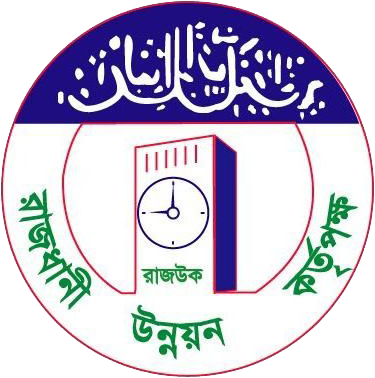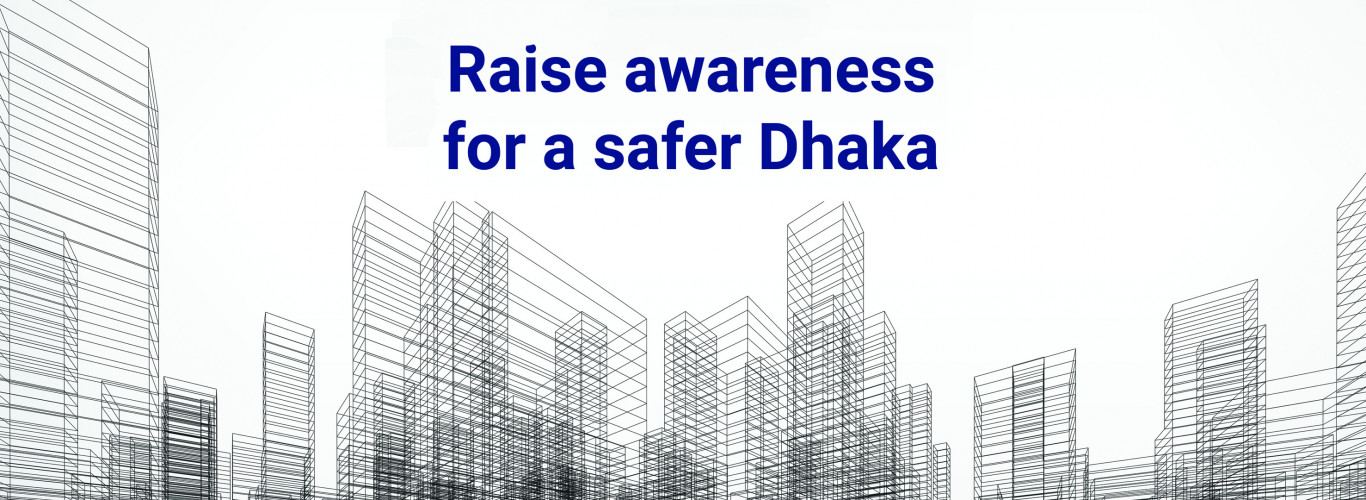Urban Resilience Project seeks to create and enabling environment for centrally coordinated and locally managed Disaster Risk Management (DRM). There are three core pillars of disaster resilience in urban settings as described in figure below including : i) Effective emergency management; ii) Improving structural resilience through reduction of existing physical vulnerability and iii) Risk-sensitive land use planning and safe construction standards practices to ensure sustainable growth.
Project Sponsoring Ministry Ministry of Housing & Public Works (MoHPW) and Project Executing Agency Rajdhani Unnayan Kartripakkha (RAJUK).
The overall objective of this project is: “To strengthen the capacity of GoB agencies to efficiently and effectively respond to emergency events in Dhaka and Sylhet; the secondary objective is to improve quality of new construction in Dhaka and Sylhet.”
The specific objectives of this sub-project are to implement Components B and C, which are comprised of the following goals:
- Conduct a Vulnerability Assessment of Critical and Essential Facilities and Lifelines
- Support the Development of a Risk-Sensitive Land Use Planning Practice in Dhaka
- Create and Operationalize an Urban Resilience Unit (URU) in RAJUK
- Establish an Electronic Construction Permitting System
- Set Up a Professional Accreditation Program for Engineers, Architects and Planners
- Improve Building Code Enforcement within RAJUK Jurisdiction
City-level actors are critical to the effort to develop resilient and livable cities in Bangladesh. Urban Resilience Project seeks to create and enabling environment for centrally coordinated and locally managed Disaster Risk Management (DRM).
The Three Core Pillars of Urban Disaster Resilience
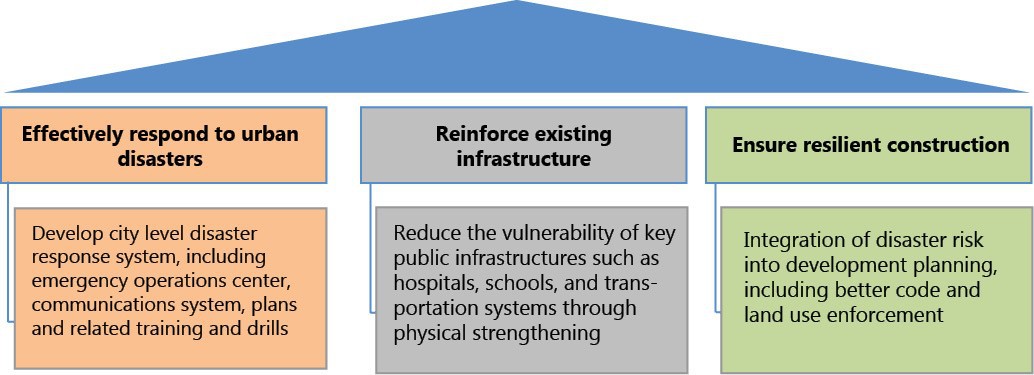
Urban Resilience Project (URP): RAJUK Part
LOG FRAME - PROJECT DESIGN AND MONITORING FRAMEWORK
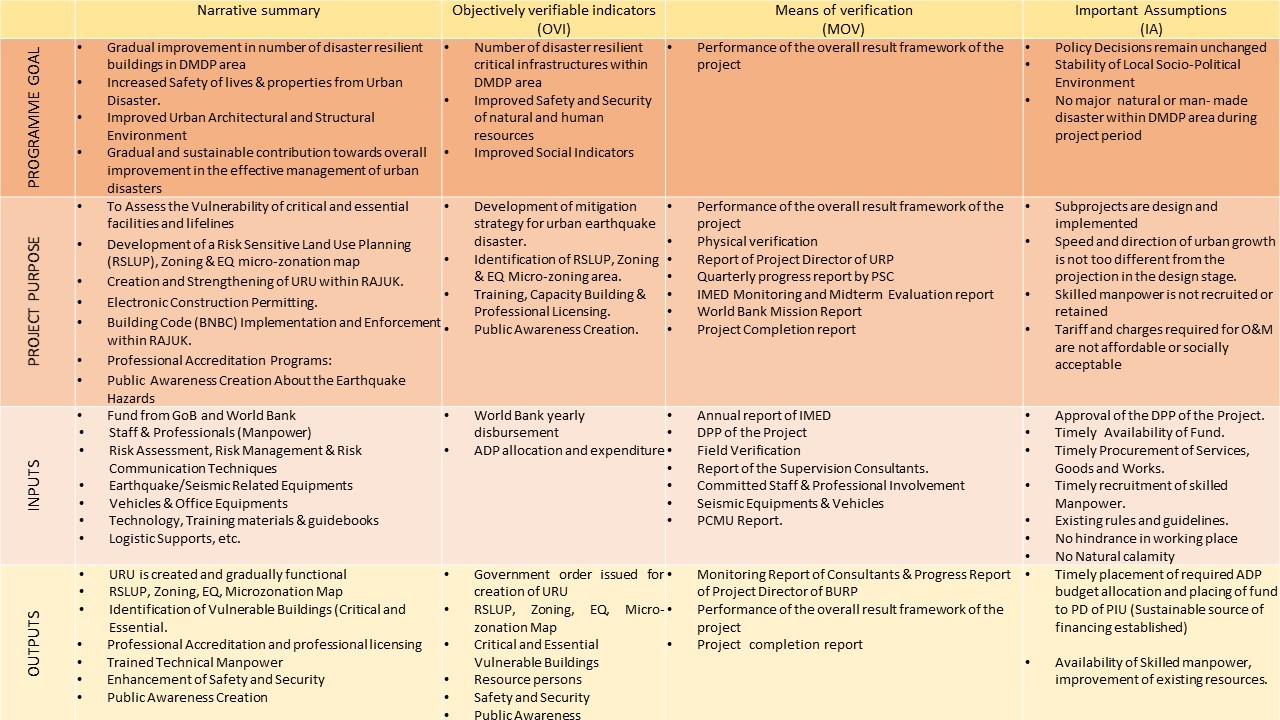
Main Components of the project
1. Component A: Reinforcing the Country’s Emergency Management Response Capacity
2. Component B: Vulnerability Assessment of Critical and Essential Facilities
3. Component C: Improve Construction, Urban Planning and Development
4. Component D: Project Coordination, Monitoring and Evaluation
Among these, component B and C will be implemented by “Urban Resilience Project (URP): RAJUK Part.
Sub-Components of the Project
Component B: Vulnerability Assessment of Critical and Essential Facilities includes-
a) The objective of this component is to develop the consensus-driven analytical foundation required for longer-term investments and to reduce risk in the built environment of Dhaka, Sylhet and other cities in Bangladesh.
b) It concentrates on two activities: i) an assessment of the vulnerability of the built environment in greater Dhaka to earthquakes and other major hazards, focusing on essential and critical facilities and infrastructure. The assessment will establish the patterns of vulnerability of the cities, understand the hotspots, and serve as a basis for a long term vulnerability reduction in greater Dhaka; and ii) the development of risk-sensitive land use planning as a practice in Bangladesh. This will be informed by an understanding of the hazards, vulnerability and risk facing urban centers, and by clearly stated consensus-driven DRR objectives and policies.
Component B1: Conduct a Vulnerability Assessment of Critical and Essential Facilities and Lifelines.
This component aims to identify at-risk public infrastructure, including critical and essential facilities and lifelines, assess their vulnerability to earthquakes and other hazards, and develop a city-wide vulnerability reduction program which includes priorities and budgets for physical strengthening, retrofitting or replacement. The assessment will establish the patterns of vulnerability of the city, identify the hotspots, and serve as a basis for a long term vulnerability reduction in Greater Dhaka. The following tasks are envisioned in implementing Component Bl:
B1a. Preparation of a Database of Critical and Essential Facilities
– Collection of satellite imagery and development of urban characteristics and patterns
– Preparation of a GIS database
– Digitization and inclusion of data collected by TITAS and DWASA
– Collection and review of past studies; and extension of HVRA to Greater Dhaka
B1b. Survey for a Structural Vulnerability Assessment
– Development of methodology of survey and assessment
– Resource mobilization with manpower and equipment,including training of assessors
– Physical survey of critical facilities by RAJUK
– Physical survey of gas pipelines by TITAS Gas
– Physical survey of water pipelines by DWASA
B1c. Analysis of Output Development for a Vulnerability Reduction Strategy and Program
– Analysis of outputs and presentation of output
– Consultations with various agencies and building facilities owners
– Development of the strategies, programs, projects and activities for vulnerability reduction of critical and essential facilities, water systems and gas systems with budget priorities
B1d. Consultations, Education and Awareness Campaign
Component B2: Support the Development of a Risk-Sensitive Land Use Planning Practice in Dhaka
Component B2 will support the conduct of risk-sensitive planning exercises for Metropolitan Dhaka in coordination with the findings and outputs of Component B1. The following activities will be implemented under Component B2:
B2a. Assessment of Plans and Planning System
– Review current plans and assessing gaps
– Ensure consultations and validation with stakeholders
B2b. Develop the Internal Guidelines and Processes for RSLUP
– Upgrade the current planning system
– Mainstream plan formulations
– Collect and integrate data
– Support the development of the Detailed Area Plans (DAPs)
– Provide examples and “How To” guides
– Ensure consultations and validation with stakeholders
B2c. Training and Capacity Building
– Develop curriculum and training methodology
– Conduct various trainings and assessments
B2d. Database Management and Outreach
– Establish technical and administrative processes
– Develop database management
– Conduct outreach around land use plan
Component C: Improved Construction, Urban Planning and Development
a) The objective of Component C is to put in place the institutional infrastructure and competency to reduce long-term disaster vulnerability in Dhaka. It would address both the existing built environment as well as future development. The overall scheme for Component C covers four areas of investment, which described below:
- Component C1: Create and Operationalize an Urban Resilience Unit (URU) in RAJUK
- Component C2: Establish an Electronic Construction Permitting System
- Component C3: Set Up a Professional Accreditation Program for Engineers, Architects and Planners
- Component C4: Improve Building Code Enforcement within RAJUK Jurisdiction
Component C1: Create and Operationalize an Urban Resilience Unit (URU) in RAJUK
This component will fund activities related to setting up of an Urban Resilience Unit (URU) within RAJUK to develop human and capital resources, both in number and capacity, to undertake urban resilience activities. In particular, it will oversee the implementation of the Bangladesh National Building Code (BNBC), accreditation and code enforcement provisions, and implementation of building construction standards. The URU will also serve as RAJUK’s project implementation unit (PIU) for Components B and C, which will be implemented by RAJUK. The following activities will be implemented under Component Cl:
Cla. Structural and Organizational setup of URU, including human resources
Clb. Renovation of office space
Clc. Laboratory and field testing equipment
Cld. Community outreach, campaign and activities
Cle. Development of training facility
Clf. Program development and technical assistance
Component C2: Establish an Electronic Construction Permitting System
This component will fund the design, development and implementation of an electronic permitting and monitoring system (e-permit) for construction applications. The funding will include a feasibility study, the design, development, testing, training, as well as deployment of the system, and related infrastructure (software and hardware necessary for institutionalization). The objective is to make construction permitting more efficient and transparent. The following activities will be implemented under Component C2:
C2a. Feasibility study and institutional setup
C2b. E-permit software design, testing and release
C2c. Hardware, software, equipment and operations
C2d. Human Resources
C2e. Trainings, Seminars, Workshops, Symposiums, Study Tours and Short Courses
Component C3: Set Up a Professional Accreditation Program for Engineers, Architects and Planners
Component C3 will serve to improve the professional competency and ethical standards of practice of professional engineers, architects, planners and other construction professionals according to Bangladesh building code and international standards of practice. The objective is to develop a new program aimed at delivering a recognized professional accreditation based on international best practices. A major effort will go into developing the curriculum, requirements for skills and experience, and certification documentation agreed upon and accepted by the professional engineering community.
Component C3 will also first oversee a consultation process with stakeholders to establish a working relationship with RAJUK and the MoHPW. The Professional Accreditation Program should be promoted and the demand and requirements should be defined through a participatory process. In consultation with the professional associations, academia, building design and construction industry, an Accreditation Advisory Panel should be convened to help build consensus around the parameters and conditions for the accreditation program and establish standards.
The following activities will be implemented under Component C3:
C3a. Consultation Process with Stakeholders
– Establish a working relationship with stakeholders, RAJUK and MoHPW
– Agree on the creation of the Accreditation Advisory Panel
– Define its terms of references and operating process
– Handle operating costs related to the activities of the Accreditation
C3b. Research and Analytical Formulation
– Develop understanding of BNBC enforcement mechanisms, agenda and proceduresfor deputized inspectors and accreditation
– Research other models
– Prepare institutional set-up; examine legal provisions on accreditation
– Prepare administrative and technical provisions
– Ensure consultations, validations and endorsements from the Accreditation Advisory PaneLMoHPW, Engineering Professional Organizations, the Construction and Real Estate industrv, and other concerned agencies
C3c. Operationalization, Monitoring and Evaluation
– Assessment of human resource requirements
– Assessment of administrative and logistical requirements
– Pilot testing
– Development of a roll-out mechanism
– Monitoring and evaluation
C3d. Establishment of a Platform for Continuing Education and Training to Support Certification
– Preparation of delivery mechanisms (on-line, face-to-face, etc.)
– Preparation of curriculum and materials
– Delivery of short courses, preparatory tests and study toursEvaluation and monitoring
C3e. Outreach and Educational Campaign
– Symposiums and workshops with professional bodies
– Guides, publications, and informational materialPartnerships and networks
– Media engagement (including digital)
Component C4: Improve Building Code Enforcement within RAJUK Jurisdiction
This Component will build the capacities and administrative structure for RAJUK to implement and enforce the BNBC, the provisions of the Structure Plans and DAP, and building field inspection and controls. This funding is confined to RAJUK’s jurisdictional responsibilities and mandate.
The following activities will be implemented under Component C4:
C4a. In-depth feasibility and assessment study
C4b. Development of Processes, technical criteria, reporting and recourse mechanism for code
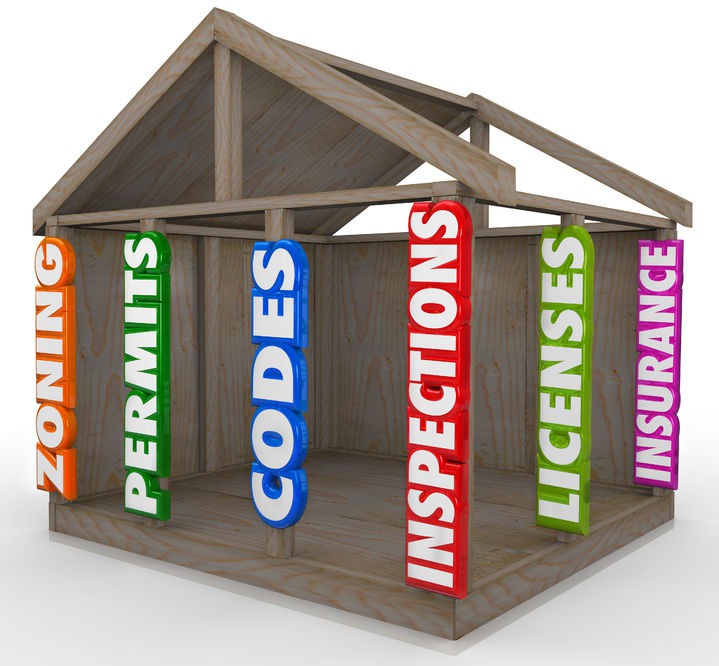
Implementation and enforcement
C4c. Operationalization of enforcement mechanisms
C4d. Building public awareness about building code enforcement
C4e. Capacity Building and continuing education
Four international consulting firms have already been engaged in the project and started their activities. These are:
1. NKY Engineers, Turkey for vulnerability assessment of critical and essential facilities and lifelines.
2. NKY Engineers, Turkey for Development of Risk-Sensitive Land Use Planning Practice in Dhaka.
3. RTI International, USA for Create and Operationalize Urban Resilience Unit Within RAJUK.
4. RTI International, USA for Electronic Construction Permit System.
5. International Code Council, USA forBuilding Code enforcement within RAJUK jurisdiction.
6. JV of BAUM Architects (South Korea); Structural Engineers Company; Engineers and Planners; Bangladesh for Design and Supervision of Research, Training, Testing and Laboratory Building.

